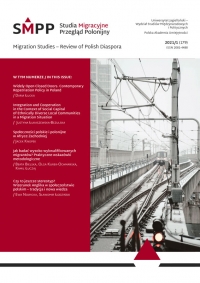Snowball Sampling vs. Respondent Driven Sampling in Regional Research. Comparing the use of the Methods to Study Migrants Working in Elderly Care
Snowball Sampling vs. Respondent Driven Sampling in Regional Research. Comparing the use of the Methods to Study Migrants Working in Elderly Care
Author(s): Sabina Kubiciel-LodzińskaSubject(s): Social Sciences, Sociology, Migration Studies
Published by: Wydawnictwo Uniwersytetu Jagiellońskiego
Keywords: elderly carers; migrants; snowball sampling; hard-to-survey population; Respondent Driven Sampling; labour market
Summary/Abstract: The aim of the article is to compare the effectiveness of the snowball sampling and Respondent Driven Sampling (RDS) for research on migrants working in elderly care. Analyses are based on results of in-depth semi-structured individual interviews conducted among 42 migrants working as caregivers in the Opole region (Poland). This group can be considered as a “hidden population” because, due to the work they provide in the household, frequently illegally, they often demonstrate a strong desire to remain invisible. The methods were compared in terms of: (1) duration of the survey, (2) diversity of the sample, (3) difficulty in applying both sampling methods. In the conducted survey, snowball sampling made it possible to find and reach the required number of respondents faster than the RDS. Both groups differed in terms of gender (more men were recruited by snowball sampling), legality of employment (there were fewer lawfully employed in the RDS group) and average length of stay in Poland (migrants recruited by snowball sampling stayed in Poland for an average of 3.3 years and enrolled by RDS for 1.7 year). In both groups, recruitment was not self-driven by the chain of social networks of respondents. The reason was, inter alia, the structure of the social network of the migrant, which only to a small extent covered other migrants employed in senior care. The article closes the research gap for comparative research using snowball sampling and RDS on the same hard-to-reach population. The survey also attempts to verify to what extent face-to-face RDS can be used to survey hidden and rare populations scattered over a larger area than a city or agglomeration. Therefore the RDS method has been used to recruit respondents from the whole region without limiting the scope to one city or agglomeration.
Journal: Studia Migracyjne - Przegląd Polonijny
- Issue Year: 2021
- Issue No: 1
- Page Range: 149-180
- Page Count: 32
- Language: English

